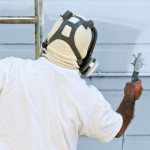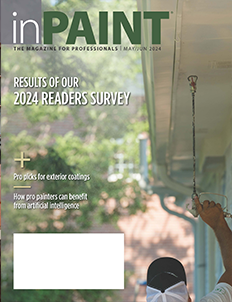Safety Training: Why it Pays
 On a clear, sunny day out in the fresh air, safety and health might be the last thing on your mind. But data from the Bureau for Labor Statistics indicate that dangers for painters come in many forms.
On a clear, sunny day out in the fresh air, safety and health might be the last thing on your mind. But data from the Bureau for Labor Statistics indicate that dangers for painters come in many forms.
First and foremost are falls from ladders or scaffolds. Of the 738 worker fatalities in construction in 2011, 31 of them involved workers in the painting industry. But painters also face repetitive stress injuries such as tendonitis and carpal tunnel syndrome; exposure to dangerous chemicals and molds, bacteria or fungi; overexertion from lifting heavy ladders, paint buckets and equipment; and accidental paint-gun injuries. While many of those latter factors may not be as sudden or lethal as a fall, they still cost employers and employees significantly in missed workdays, lower productivity, and even shortened careers.
PUTTING THE FOCUS ON SAFETY
So, what can you do to ensure you and your crews are focused on safety? For many contractors, it starts with the federal Occupational Safety & Health Administration (OSHA), which sets the overall national standards for workplace safety, guiding employers to offer a workplace free from recognized hazards and ensuring that employees comply with the various rules, regulations and orders. Items that most frequently impact painting contractors include fall protection, hazard communications, scaffolding and ladders, and respiratory protection. The good news is that workplace fatalities, occupational injury, and illness rates are down well over 60% since 1970, in part because of OSHA’s efforts.
But from a painting contractor’s perspective, OSHA regulations generally serve only as a baseline. “OSHA establishes the minimums for training for the employer and employee, but you really have to use that as a default and take everything a step further,” says Rick Swaringen, project manager at St. Louis-based Koch Bros. Decorating, Inc. “That way, if anything goes wrong, you’re still in a safe situation.”
In addition to two major corporate safety meetings a year, all of the company’s employees participate in a 10-hour OSHA construction outreach training. In turn, those programs are augmented by an apprentice program and regular refreshers on hot-button topics such as ladder and scaffold safety, the use of flammable and combustible materials, and personal protective equipment. The company was also among the first in the nation to offer trainer-certified programs for the Environmental Protection Agency’s (EPA) Lead Renovation, Repair and Painting (RRP) rule for projects that disturb lead-based paint in homes, childcare facilities and preschools built before 1978.
“Most of our guys in the field have been around a long time and they’re very experienced, but the only way you get to be older and experienced is keeping yourself healthy and safe,” Swaringen says. “A lot of them are close enough to retirement that it’s tangible, and they understand the importance of focusing on safety. With the younger guys, you need to help them form good habits—because that’s much easier than breaking bad habits.”
THINKING BEST PRACTICES
“There are really two components to health and safety training,” says Kevin Cannon, director of Safety & Health Services for The Associated General Contractors of America (AGC), a national trade association based in Arlington, Virginia that represents all commercial contractors. “You have to give the workers the knowledge about hazards from any given task that they’re performing. But in addition to recognition, you have to identify how to correct or abate such hazards.”
Like Swaringen, Cannon believes that OSHA is best used as a minimum standard rather than a gold seal of approval. “Sure, you can focus strictly on compliance, not getting cited or penalized for violations, but I think it goes beyond that,” he says. “Trade associations like ours are focused on best practices, going above and beyond what’s required. The reason is this: You can have 100% compliance with OSHA, but that doesn’t mean you’ve completely eliminated the chance for injury or illness. It’s one of those things that make good business sense. If you protect yourself, you can save a lot of money on things like workers’ compensation.”
Painting and Decorating Contractors of America (PDCA) emphasizes the importance of reaching out with a safety message in different formats. The organization offers its members safety awareness in regular newsletters and video tips, as well as through publications on its online store—including updated OSHA safety training handbooks and hazardous communications safety handbooks for reference and for training employees. Members seeking accreditation are required to submit an extensive safety-training program for their company, and tools on the organization’s ContractorCollege.org help them create a plan. In October, PDCA launched a partnership with Safety International to offer a safety help hotline, which provides verbal advice and discounted incentive plans.
“Our curriculum includes monthly webinars, and a few times of year, we have consultants or OSHA representatives to do training,” says Libby Loomis, education director for PDCA. “And our annual convention offers onsite safety training by OSHA, and consultants—plus, we have an OSHA rep on the tradeshow floor.”
In addition to all the training and education, Loomis underscores the importance of creating safety plans, programs, and manuals—then keeping them current and top of mind, and constantly cultivating a safety mentality within your workforce. “A lot of our members choose to take advantage of our education program, Contractor College, and also achieve PDCA accreditation,” she says. One of the important pieces of the PDCA accreditation program is implementing safety programs, which require you to create, implement, and follow a safety plan. We provide online tools to help with this, such as examples of company safety plan templates and checklists that include safety plan module topics to be included in the plan. But the main piece of advice I can give, whether you’re a member of our organization or not, is the importance of having a formalized safety plan. Talking about it isn’t enough.”
Swaringen has seen the focus on safety training increase significantly in the past 15 years. “In the old days, say 20 years ago, a lot of contractors would do the training but there wasn’t much follow through,” he says. “Today, the big general contractors are much more stringent about their policies, and in custom homes, often even more. Safety training has come a long way, and it’s something that’s a real positive factor for the industry.”
SAFETY RESOURCES
In addition to OSHA and EPA standards, there are a variety of state and municipal jurisdictions that have their own rules that may apply to your painting contracting business. “There are a lot of resources out there,” says Swaringen. “But you really need to research and see what works for your business and your locality.” While you might be reading the trade magazines to stay current, he says, it can also help to seek out the multiple resources in your area—whether paid membership organizations or free information from government sources—that can help keep you in compliance and foster best practices.
The Associated General Contractors of America (AGC): agc.org
United States Environmental Protection Agency (EPA): epa.gov
Finishing Contractors Association International (FCA): finishingcontractors.org
National Safety Council (NSC): nsc.org
Occupational Safety & Health Administration (OSHA): osha.gov
Painting and Decorating Contractors of America (PDCA): pdca.org




